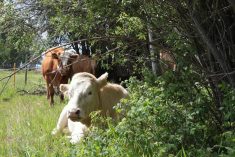Implants in the cattle industry have been used on hundreds of millions of cattle in North America and other countries. We all know the benefits that come with a very small amount of hormone in the right proportions placed in the ear give us both increased gain and feed efficiency. Gains will increase (10-25 per cent) and feed efficiency will rise up to 15 per cent. The amount of improved gain depends on the cattle type which includes such things as breed, gender as well as phenotype. The amount and quality of feed as well as the type of implant (concentration of the androgenic and estrogenic hormones) as well as the length of time the implant lasts all have a bearing on the final improvement in gain.
Read Also

Mosquito-borne virus could be devastating to sheep breeding operations
Cache Valley virus, a mosquito-borne disease that infects small ruminants, could be a devastating hit to small operations.
You can start with some implants as soon as castration occurs and it is wise to implant your non-replacement heifers as well. Younger calves have a better feed conversion rate so the younger you start the quicker gains are realized. Work with your herd veterinarian on an implant program that best maximizes the gains possible on your ranch and stick with it. The extra effort is well worth it.
Handling
With chutes now having neck restraint bars and shoulder restraint devices it is much easier to implant. Guns are designed so crushing of implants as well as bunching are pretty much a thing of the past. Make sure and swipe the implant needle through a disinfectant after use. We want to implant properly to get the maximum benefit but we always say the worst-case scenario comes from not implanting at all. Make sure and work out with your veterinarian an implant program customized to your farm.
There have been hundreds of trials comparing implants against one another or comparing calves implanted versus not implanted. Hundreds of these trials go back over the decades and now the only trials one sees is when a new implant hits the market. Weight gains vary from 20 pounds to much more than that with the longer-lasting finishing implants. Most of the implants use a combination of estrogens and androgens (either natural or synthetic) to achieve better weight gains. The synthetic androgen TBA trenbolone acetate has more of an impact on growth and less on behaviour as the natural hormone testosterone. Hundreds of millions of cattle have been implanted over the years and most multiple times with no real side-effects.
Returns
Implants will return a conservative 15-25 to 1 return. If you don’t implant you should consider it as otherwise you are leaving many dollars on the table. As soon as bull calves are castrated is a good time. Remember that young calves have a greater feed efficiency and conversion rate (four pounds of feed for one pound of gain) so younger is ideal to start most implant programs. The only few exceptions to this would be keeping heifers for breeding or intact bulls. If you can market into a branded program where calves with no growth promotants are to be enrolled; that is fine but those calves should be worth in the neighbourhood of 20 per cent more to compensate for the extra gains and feed efficiencies you are forgoing from not being able to use the growth-promoting technologies (implants, deworming, ionophores and beta-agonists). Without the implants it simply takes more time and more feed to produce the same weight of calf.
Safety
We all need to know how safe growth implants are. They are all given in the ear so none of the residual product enters the food chain. Hence all the implants have a zero meat withdrawal. It would be a loss of money to give the implant too close to slaughter so most astute producers have the implant running out just prior to slaughter.
Most of the three big pharmaceutical companies that produce implants spend resources explaining to producers and the general public about the safety of implants. They are so safe it is really a non-issue in my opinion. It is too bad big business such as A&W in their recent ad campaign tries to cast doubt on the subject. The fact of the matter is that ranching is more sustainable with the use of implants among other things to assist in growth.
A lot of countries such as many in the European Union raise and slaughter intact bulls so not the need to implant. Other countries calve on vast stretches of land so don’t handle the cattle enough to implant. Other species such as bison utilize the natural hormones by leaving bulls intact and maximize their growth that way. North America has a much more hands-on style of management so might as well get maximum production fully utilizing the genetics and growth potential of their cattle by implanting.
Many plant products that we consume have much higher levels of estrogens than our implanted beef. We need to all take the next message forward to the consuming (urban and rural) public as often we get push-back as they have been ill informed or simply have a total misconception about the safety of implanted beef. Even some producers have this ill-conceived notion.
Again unless calves are in some branded or natural-type program 95 per cent of calves entering the feedlot are implanted immediately. This is again why A&W has had to go out of country to places like Australia and the U.S. to get enough no-added-hormone product for its burgers.
The reality is from a green perspective faster-growing cattle produce less greenhouse gases, utilize less land and drink less water over their lifetime and are thus more efficient. If no cattle were implanted, dewormed or given other growth-promoting technologies beef would cost even more to raise.















